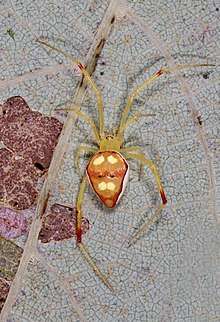Spintharus
The spider genus Spintharus occurs from the northeastern United States to Brazil. Nicholas Marcellus Hentz circumscribed the genus in 1850, initially as a monospecific genus containing his newly described species S. flavidus.[2]
| Spintharus | |
|---|---|
 | |
| S. flavidus from Maryland. | |
| Scientific classification | |
| Kingdom: | Animalia |
| Phylum: | Arthropoda |
| Subphylum: | Chelicerata |
| Class: | Arachnida |
| Order: | Araneae |
| Infraorder: | Araneomorphae |
| Family: | Theridiidae |
| Genus: | Spintharus Hentz, 1850[1][2] |
| Type species | |
| Spintharus flavidus Hentz, 1850[1] | |
| Species | |
|
See text. | |
| Diversity | |
| c. 18 extant species; 1 fossil species | |
It is very similar to the genus Thwaitesia, and both are similar to Episinus. Unlike Argyrodes, they have two setae in place of a colulus.
Specimens of S. flavidus are variable in structure. Only some have an elevated eye region or humps on the anterior of the abdomen.
Females of S. gracilis are 3.7mm long, males 2.3mm.
A revision of the genus by Ingi Agnarsson and colleagues printed in 2018 included the description of fifteen new species, as well as the removal of S. argenteus.[3] Some of the new specific names were named in honor of political figures, artists, and celebrities.[4] As of 2017, when the electronic pre-print was published, Spintharus was the spider genus with the most species named after celebrities.[5]
An earlier revision of the genus was by Herbert Walter Levi; his taxonomy recognized two species: S. flavidus and S. gracilis.[6][7]
Species

As of 2018, the World Spider Catalog (WSC), largely following Agnarsson and colleagues, accepts the following extant species:[3][1]
- Spintharus argenteus Dyal, 1935 – Pakistan
- Spintharus barackobamai Agnarsson & Van Patten, 2018 – Cuba
- Spintharus berniesandersi Agnarsson & Sargeant, 2018 – Cuba
- Spintharus davidattenboroughi Agnarsson & Van Patten, 2018 – Jamaica
- Spintharus davidbowiei Agnarsson & Chomitz, 2018 – Mexico
- Spintharus dayleae Sargeant & Agnarsson, 2018 – Saint Lucia, Grenada
- Spintharus flavidus Hentz, 1850 (type species) – USA, Central and South America
- Spintharus frosti Van Patten & Agnarsson, 2018 – Dominican Republic
- Spintharus giraldoalayoni Agnarsson & Chomitz, 2018 – Cuba
- Spintharus goodbreadae Chomitz & Agnarsson, 2018 – Cuba
- Spintharus gracilis Keyserling, 1886 – Brazil
- Spintharus greerae Sargeant & Agnarsson, 2018 – Mexico
- Spintharus jesselaueri Sargeant & Agnarsson, 2018 – Dominica
- Spintharus leonardodicaprioi Van Patten & Agnarsson, 2018 – Dominican Republic
- Spintharus manrayi Chomitz & Agnarsson, 2018 – Cuba
- Spintharus michelleobamaae Agnarsson & Sargeant, 2018 – Cuba
- Spintharus ralli Chomitz & Agnarsson, 2018 – Puerto Rico, Saint Kitts and Nevis
- Spintharus skelly Van Patten & Agnarsson, 2018 – Dominican Republic
Although as of 2018, the WSC accepts S. argenteus as a species, Agnarsson and colleagues argued it to be a nomen dubium or at the very least misplaced in this genus saying it might belong in the family Tetragnathidae.[3][8] Levi had also earlier said this species "is probably not a Spintharus".[6]:79
The WSC also recognizes one fossil species in the genus:[9]
- † Spintharus longisoma Wunderlich, 1988 — Dominican amber
Formerly accepted species in Spintharus include:[1]
- Spintharus minutus Petrunkevitch, 1926 (= Theridion antillanum Simon, 1894)[10][11]
- Spintharus hentzi Levi, 1955 (= Spintharus flavidus Hentz, 1850)[7]
References
- "Gen. Spintharus Hentz, 1850". World Spider Catalog. Natural History Museum Bern. Retrieved 2 May 2018.
- Hentz, Nicholas Marcellus (1850). "Descriptions and Figures of the Araneides of the United States". Boston Journal of Natural History. 6 (2): 283–284; Pl. 10, Fig. 8.
- Agnarsson, Ingi; Van Patten, Chloe; Sargeant, Lily; Chomitz, Ben; Dziki, Austin; Binford, Greta J. (2018). "A radiation of the ornate Caribbean 'smiley-faced spiders', with descriptions of 15 new species (Araneae: Theridiidae, Spintharus)". Zoological Journal of the Linnean Society. 182 (4): 758–790. doi:10.1093/zoolinnean/zlx056.
- Guarino, Ben (26 September 2017). "Meet Bernie Sanders's new namesake: A spider from Cuba". Washington Post.
- Mammola, Stefano; Michalik, Peter; Hebets, Eileen A.; Isaia, Marco (2017). "Record breaking achievements by spiders and the scientists who study them". PeerJ. 5 (e3972): 12–13. doi:10.7717/peerj.3972. PMC 5668680.
- Levi, Herbert W. (1954). "The Spider Genera Episinus and Spintharus from North America, Central America and the West Indies (Araneæ: Theridiidæ)". Journal of the New York Entomological Society. 62 (2): 65–90. JSTOR 25005540.
- Levi, Herbert W. (1963). "The American Spider Genera Spintharus and Thwaitesia (Araneae Theridiidae)". Psyche: A Journal of Entomology. 70 (4): 223–234. doi:10.1155/1963/54690.
- Dziki, Austin; Binford, Greta J.; Coddington, Jonathan A.; Agnarsson, Ingi (2015). "Spintharus flavidus in the Caribbean—a 30 million year biogeographical history and radiation of a 'widespread species'". PeerJ. 3: e1422. doi:10.7717/peerj.1422.
- Dunlop, J. A.; Penny, D.; Jekel, D. (2017). "A summary list of fossil spiders and their relatives" (PDF). World Spider Catalog. 18.5. Natural History Museum Bern. p. 161. Retrieved 28 September 2017.
- Bryant, Elizabeth B. (1942). "Notes on the Spiders of the Virgin Islands". Bulletin of the Museum of Comparative Zoölogy at Harvard College. 89 (7): 343–344.
- Levi, Herbert W. (1959). "The spider genera Achaearanea, Theridion and Sphyrotinus from Mexico, Central America and the West Indies (Araneae, Theridiidae)". Bulletin of the Museum of Comparative Zoölogy at Harvard College. 121 (3): 116.
External links
